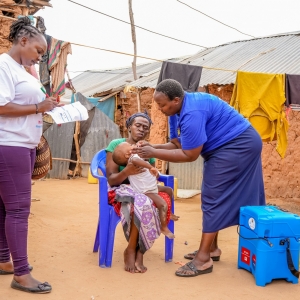Federal Water Tap, May 1: White House Establishes Office of Environmental Justice
The Rundown
- The U.S. Fish and Wildlife Service funds projects to improve fish passage in streams.
- President Biden’s executive order establishes an Office of Environmental Justice.
- The Bureau of Reclamation will release extra water to Lake Mead in this wet year.
- The EPA’s watchdog audits the agency’s oversight duties in jet fuel leak at Hawaiʻi military base.
And lastly, congressional representatives ask the EPA to take stronger action against industries that dump PFAS into waterways.
“Defense spending tends to get a lot of attention but we cannot forget that our rivers and our waterways are some of the most critical resources we have. Effective water management is essential to keeping our families healthy, our environment thriving, and our economy competitive.” — Sen. Patty Murray (D-WA), speaking during a Senate Appropriations subcommittee hearing on the fiscal year 2024 budget for the Army Corps of Engineers and Bureau of Reclamation.
By the Numbers
$35 Million: Funding to address culverts, dams, levees, and other man-made obstacles that block the movement of fish. Thirty-nine fish passage projects will be funded in 22 states this fiscal year from money made available through the Infrastructure Investment and Jobs Act.
31: Congressional representatives who signed a letter asking the U.S. Environmental Protection Agency to take a firmer stance against industrial discharges of PFAS into waterways. Signatories asked the agency to develop effluent standards for four additional industries: electrical and electronic components; leather tanning and finishing, paint formulating; and plastics molding and forming.
$140 Million: Water conservation and efficiency funding that the Department of the Interior awarded to irrigation districts, cities, and water districts. The funds pay for projects like new water meters, turf removal rebates, and piping water in irrigation ditches.
News Briefs
Environmental Justice Executive Order
President Biden signed a wide-ranging executive order intended to prioritize the pollution concerns of low-income and minority communities in federal decision-making.
As a central point of contact, the order establishes an Office of Environmental Justice within the Council on Environmental Quality, the office that oversees environmental reviews.
The order requires agencies to identify disproportionate pollution burdens of federal actions and mandates that they develop a strategic plan for guidance.
The Office of Science, Technology, and Policy will organize a subcommittee to advance data, research, and science on environmental justice.
In context: How Can the Biden Administration Deliver on Environmental Justice Pledges?
Studies and Reports
Lake Powell Water Releases Increased
Due to a wet winter, the Bureau of Reclamation will release more water from Lake Powell into Lake Mead – bonus water that will raise the water level in the struggling reservoir.
Instead of 7.48 million acre-feet, Reclamation will release up to 9.5 million acre-feet from Powell.
Expected inflow to Powell during the April-to-July period is way up: 177 percent of the 30-year average.
The extra water allowed Reclamation to open the spigots for a high-flow release from Powell last week. Upping the flow rate five times higher than typical allows the river to move sediment downstream.
Water Contamination from Hawaiʻi Military Base
A report from the EPA’s internal watchdog says that the agency should develop a plan for monitoring the removal of fuel from storage tanks at Joint Base Pearl Harbor-Hickam.
A fuel leak occurred at the Navy’s Red Hill storage facility on Oʻahu in November 2021. Jet fuel entered an aquifer that provides about a quarter of the island’s residents with drinking water.
The Defense Department decided a year ago to shut down the Red Hill facility and remove the fuel stored there.
Climate Change and Children’s Health
The EPA released a report showing the impacts of a warming planet on children’s health. Waterborne pathogens could spread more easily. Flooding could result in homes with more mold, which can trigger asthma and respiratory illnesses.
On the Radar
House Hearing on Minnesota Minerals
A House Natural Resources subcommittee will hold a field hearing on May 2 to discuss mineral resources in northern Minnesota.
The area is rich in minerals, but Democratic administrations have blocked projects near the Boundary Waters Canoe Area Wilderness out of concern for water quality.
Senate Hearing on Army Corps
The Senate Environment and Public Works Committee will hold a hearing on May 3 to discuss the Army Corps’ 2024 budget and how the agency is implementing the 2022 Water Resources Development Act.
Federal Water Tap is a weekly digest spotting trends in U.S. government water policy. To get more water news, follow Circle of Blue on Twitter and sign up for our newsletter.
Brett writes about agriculture, energy, infrastructure, and the politics and economics of water in the United States. He also writes the Federal Water Tap, Circle of Blue’s weekly digest of U.S. government water news. He is the winner of two Society of Environmental Journalists reporting awards, one of the top honors in American environmental journalism: first place for explanatory reporting for a series on septic system pollution in the United States(2016) and third place for beat reporting in a small market (2014). He received the Sierra Club’s Distinguished Service Award in 2018. Brett lives in Seattle, where he hikes the mountains and bakes pies. Contact Brett Walton







I would like to express my appreciation for your informative article on the establishment of the Office of Environmental Justice by the White House. The creation of this office marks a significant step in addressing environmental disparities and promoting environmental justice in our society.
Your article effectively highlights the importance of addressing environmental justice concerns and the role of the newly established Office of Environmental Justice. By bringing attention to the disproportionate impact of environmental issues on marginalized communities, such as low-income neighborhoods and communities of color, you shed light on the need for targeted efforts to rectify these disparities.
I found your discussion on the functions and responsibilities of the Office of Environmental Justice to be particularly valuable. By outlining its key objectives, such as developing strategies to address environmental inequities, coordinating efforts across government agencies, and engaging with affected communities, you provide readers with a comprehensive understanding of the office’s purpose and potential impact.
Moreover, your emphasis on the significance of community involvement and collaboration is commendable. Engaging directly with affected communities, listening to their concerns, and incorporating their perspectives into decision-making processes are vital for ensuring that environmental justice initiatives are effective and responsive to the needs of those most impacted.
Additionally, your article effectively conveys the potential benefits of the Office of Environmental Justice in terms of improving public health outcomes, promoting sustainable development, and advancing social equity. By addressing environmental injustices, we can create healthier and more resilient communities where everyone has access to clean air, safe drinking water, and a healthy environment.
One aspect that could have further enhanced the article is providing specific examples or case studies of environmental justice issues that the Office of Environmental Justice may address. Including real-life stories or highlighting ongoing initiatives would help readers grasp the tangible impact of this office and illustrate the importance of its work.
Furthermore, offering guidance on how individuals and communities can support and engage with the Office of Environmental Justice would be valuable. Providing information on avenues for public participation, such as public meetings, comment periods, or grassroots advocacy, would empower readers to contribute to the advancement of environmental justice.
In conclusion, your article on the establishment of the Office of Environmental Justice by the White House effectively raises awareness about environmental disparities and the need for equitable solutions. By highlighting the functions of the office and emphasizing the importance of community engagement, you provide readers with valuable insights into the steps being taken to address environmental justice issues.
Thank you for sharing this informative piece.